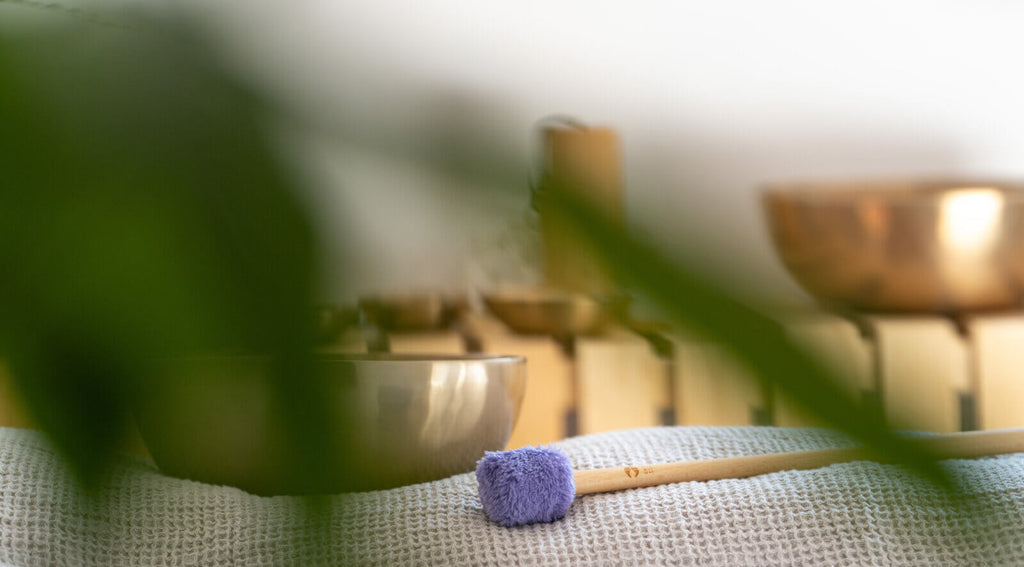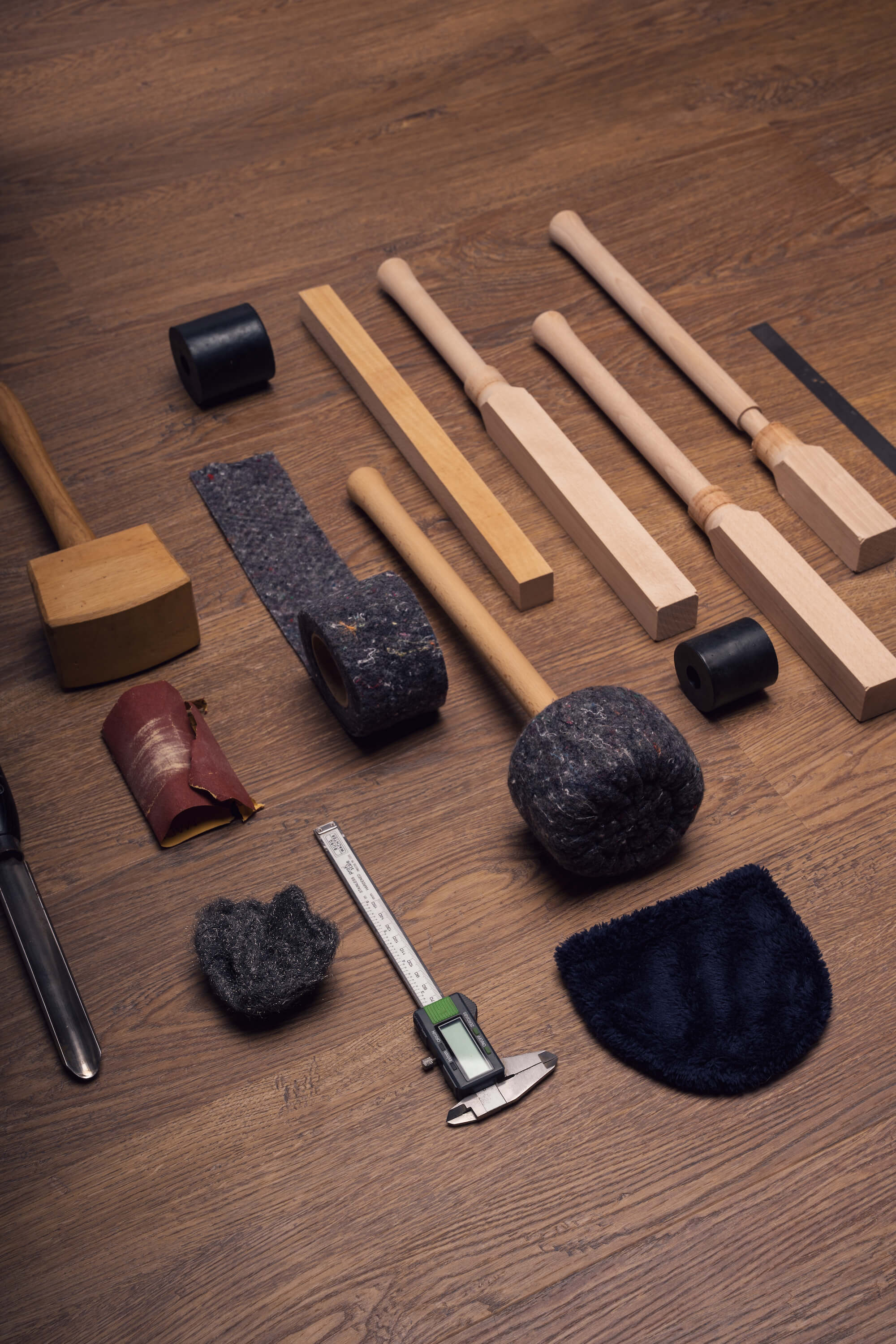The meditative effect of singing bowls and the numerous positive effects that the delicate sounds have on us are no longer controversial. In some cultures, the singing bowl has been used for hundreds of years - for example as a musical accompaniment to rituals or during meditation. If you want to use a singing bowl for the first time, you are probably wondering how best to go about it. We would like to give you an understanding of how to use a singing bowl , introduce you to suitable mallets and friction mallet - and explain what else is important when playing singing bowls.
The most important facts in brief
- The singing bowl has been used for centuries for meditation and to accompany musical rituals.
- singing bowls can be used with a mallet or a friction mallet .
- In order for the beautiful tones of the singing bowl to sound, you must first strike or rub the bowl.
- The sound also changes depending on the surface on which the singing bowl is placed.
- Mallets and friction mallet have a great influence on the sound result.
- High-quality mallets and friction mallet allow you to experience the full sound spectrum and protect the surface of the bowl.
What you need for the application of a singing bowl
Before you get down to the actual chimes, you should first make a few preparations. The first step is, of course, to choose the right singing bowl with suitable mallets. If you have no idea where to start and what the sound instrument should offer you, consult an expert. Specialist dealers who have been involved in the manufacture of singing bowls and mallets or rubbers for many years can help you to identify your needs and find the right equipment for you. The high quality of the products will later be reflected in your sound experience. After choosing the singing bowl , you should decide whether you prefer to play the chime with a mallet or a friction mallet would be better. Both variants produce a unique sound and, when used correctly, create an intense sound. However, using a friction mallet let requires a little practice. The larger a singing bowl is, the easier it will be for you to produce the singing sounds.
Which singing bowls or friction mallet is suitable for beginners?
To get started, we recommend using a mallet. The ollihess Chakra Mallet CH1, the Profi Chakra Mallet CH2, or the Profi Gong Mallet move line edition singing bowls for use with singing bowls thanks singing bowls their shape and fluffy head. They produce an intense and relaxing sound and can be played comfortably in any position. Of course, you can also friction mallet straight for a friction mallet – orfriction mallet a singing bowlsfriction mallet to your equipment at a later date. The ollihess friction mallet Edition singing bowl ideal for use with singing bowl . Its special material composition ensures a unique variety of sounds.
Preparation: How to proceed when using singing bowls
Once you have everything you need for a singing bowls application, the first step is to prepare your playing practice.
Finding the right place
It is important that you feel really comfortable and create a place where you can relax and enjoy yourself. Therefore, find a quiet and cozy place that you can adapt to the requirements of a singing bowl meditation. Make yourself comfortable Make yourself as comfortable as possible - for example with some cushions or soft blankets.
Place your singing bowl
You should also find a suitable place for the singing bowl that is easy for you to reach and at the same time offers a beautiful sound. Depending on the surface on which you place the singing bowl , its sound will also change. You can take advantage of this! A singing bowl cushion, for example, is a good option here, as it not only provides a very delicate sound, but also protects your singing bowl - and the surface on which it is placed - from scratches. Simply try out which tones you like best. This way, you can customize the singing bowls application to suit your own preferences.
singing bowl rub or strike?
If you want to use your singing bowl , you can of course decide for yourself whether you would prefer to rub it on or strike . There is basically no "right" or "wrong" here. It's all about supporting you with beautiful tones and sounds. We would therefore like to explain to you how you should rub a singing bowl or strike - and you decide what you make of it.
The singing bowl strike
For beginners in particular, strike singing bowl is often the easier approach. Once you have positioned yourself and your equipment well, you can get started: Use the mallet - another word for mallet - to gently tap the upper edge of the bowl. Depending on the material used to make singing bowl and the mallet, the resulting sound will also differ. The force with which you strike the singing bowl also influences the sound. Try it out - with soft or slightly stronger strikes, with strikes in different areas of the singing bowl and with different pads. In this way, you will find out which tones you like best when using the strike of the singing bowl and the use of the singing bowl will become a relaxing time-out for you.


Rub the singing bowl
Driving the singing bowl requires a little more practice than strike. With a little practice, however, you will quickly find out how to produce beautiful and long-lasting sounds. Here you take your singing bowlsfriction mallet and run it along the edge of the bowl in a circular motion. Continue this movement until a gentle, almost singing sound is produced. The longer you rub the singing bowl chanter against the bowl, the clearer and stronger the sound becomes. When you stop rubbing, the singing bowl will continue to resonate for some time.


How is the singing bowl positioned?
A question that we often hear from beginners to sound meditation: How do you position the singing bowl correctly? We would therefore also like to briefly explain this aspect. Basically, you can place the singing bowl on any surface on which it has a firm hold. A singing bowls cushion is particularly suitable as it supports the intensity of the sounds, but a hard surface is also possible. Many people not only want to hear the sounds of singing bowl , but also feel them intensely on their own body. You can therefore also place the singing bowl directly on the palm of your hand and then play it with the other hand.
Tip: Make sure that the flat base of the singing bowl is resting on the heel of your hand and that your fingers are loosely spread out and not touching the curved part of the bowl.
During a sound massage, the singing bowl is placed on different areas of the body, for example on the stomach. Here you can also focus on what is good for you at the time. For example, if you are suffering from pain in a certain area of your body, it often makes sense not to place the singing bowl directly at or on this point. Instead, choose an area that is further away from the pain point and play the singing bowl here. In this way, you direct the focus away from the unpleasant feelings and concentrate on the regions where you feel more well-being. This can help you to relax and reduce the pain.
Why is the singing bowls application so popular?
In recent years, the singing bowl has become a popular sound instrument that is often used in sound meditation and sound therapy - but also for pleasure in private use. This is mainly due to its multifaceted sound and the vibrations it emits, which promote well-being and relaxation. The singing bowl is now used in many areas:
- to the sound massage
- to sound therapy
- for the musical education and further training of children
- to support wellness treatments and body massages
- during meditation
- as an accompanying instrument - also for studio recordings or stage performances
Let your creativity run wild with the singing bowls application
There are no limits when rubbing or strike the singing bowl - just like when playing a gong. The rule here is: what feels good, feels good. You can therefore take your time to try out the different ways of using a singing bowl - and find the method that works best for you. Simply follow your intuition and your own feelings to play the singing bowl in the way that moves you.





